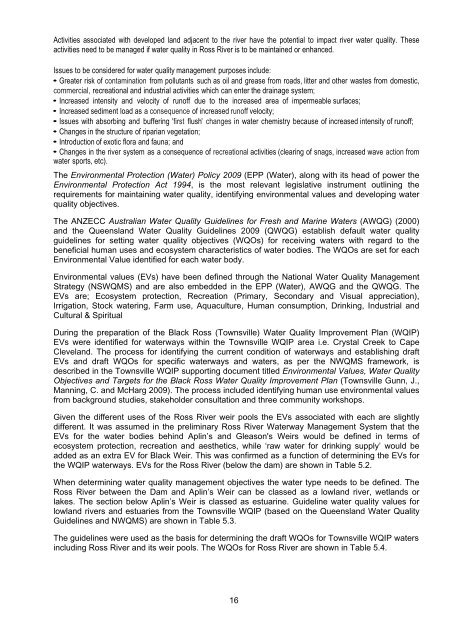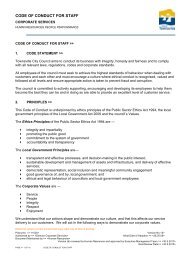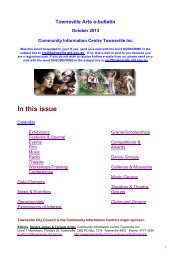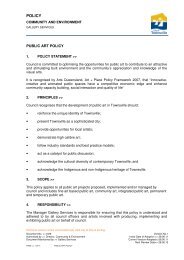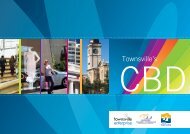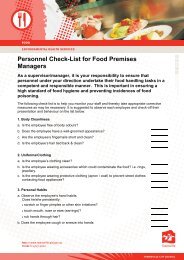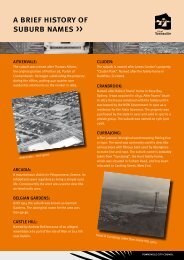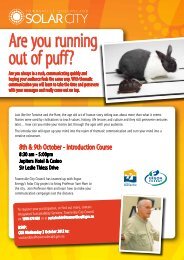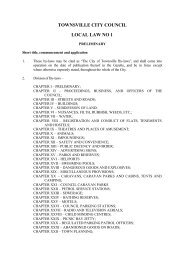Management of Recreational Use Plan 2013-2015 - Townsville City ...
Management of Recreational Use Plan 2013-2015 - Townsville City ...
Management of Recreational Use Plan 2013-2015 - Townsville City ...
- No tags were found...
Create successful ePaper yourself
Turn your PDF publications into a flip-book with our unique Google optimized e-Paper software.
Activities associated with developed land adjacent to the river have the potential to impact river water quality. Theseactivities need to be managed if water quality in Ross River is to be maintained or enhanced.Issues to be considered for water quality management purposes include:• Greater risk <strong>of</strong> contamination from pollutants such as oil and grease from roads, litter and other wastes from domestic,commercial, recreational and industrial activities which can enter the drainage system;• Increased intensity and velocity <strong>of</strong> run<strong>of</strong>f due to the increased area <strong>of</strong> impermeable surfaces;• Increased sediment load as a consequence <strong>of</strong> increased run<strong>of</strong>f velocity;• Issues with absorbing and buffering 'first flush' changes in water chemistry because <strong>of</strong> increased intensity <strong>of</strong> run<strong>of</strong>f;• Changes in the structure <strong>of</strong> riparian vegetation;• Introduction <strong>of</strong> exotic flora and fauna; and• Changes in the river system as a consequence <strong>of</strong> recreational activities (clearing <strong>of</strong> snags, increased wave action fromwater sports, etc).The Environmental Protection (Water) Policy 2009 (EPP (Water), along with its head <strong>of</strong> power theEnvironmental Protection Act 1994, is the most relevant legislative instrument outlining therequirements for maintaining water quality, identifying environmental values and developing waterquality objectives.The ANZECC Australian Water Quality Guidelines for Fresh and Marine Waters (AWQG) (2000)and the Queensland Water Quality Guidelines 2009 (QWQG) establish default water qualityguidelines for setting water quality objectives (WQOs) for receiving waters with regard to thebeneficial human uses and ecosystem characteristics <strong>of</strong> water bodies. The WQOs are set for eachEnvironmental Value identified for each water body.Environmental values (EVs) have been defined through the National Water Quality <strong>Management</strong>Strategy (NSWQMS) and are also embedded in the EPP (Water), AWQG and the QWQG. TheEVs are; Ecosystem protection, Recreation (Primary, Secondary and Visual appreciation),Irrigation, Stock watering, Farm use, Aquaculture, Human consumption, Drinking, Industrial andCultural & SpiritualDuring the preparation <strong>of</strong> the Black Ross (<strong>Townsville</strong>) Water Quality Improvement <strong>Plan</strong> (WQIP)EVs were identified for waterways within the <strong>Townsville</strong> WQIP area i.e. Crystal Creek to CapeCleveland. The process for identifying the current condition <strong>of</strong> waterways and establishing draftEVs and draft WQOs for specific waterways and waters, as per the NWQMS framework, isdescribed in the <strong>Townsville</strong> WQIP supporting document titled Environmental Values, Water QualityObjectives and Targets for the Black Ross Water Quality Improvement <strong>Plan</strong> (<strong>Townsville</strong> Gunn, J.,Manning, C. and McHarg 2009). The process included identifying human use environmental valuesfrom background studies, stakeholder consultation and three community workshops.Given the different uses <strong>of</strong> the Ross River weir pools the EVs associated with each are slightlydifferent. It was assumed in the preliminary Ross River Waterway <strong>Management</strong> System that theEVs for the water bodies behind Aplin’s and Gleason's Weirs would be defined in terms <strong>of</strong>ecosystem protection, recreation and aesthetics, while ‘raw water for drinking supply’ would beadded as an extra EV for Black Weir. This was confirmed as a function <strong>of</strong> determining the EVs forthe WQIP waterways. EVs for the Ross River (below the dam) are shown in Table 5.2.When determining water quality management objectives the water type needs to be defined. TheRoss River between the Dam and Aplin’s Weir can be classed as a lowland river, wetlands orlakes. The section below Aplin’s Weir is classed as estuarine. Guideline water quality values forlowland rivers and estuaries from the <strong>Townsville</strong> WQIP (based on the Queensland Water QualityGuidelines and NWQMS) are shown in Table 5.3.The guidelines were used as the basis for determining the draft WQOs for <strong>Townsville</strong> WQIP watersincluding Ross River and its weir pools. The WQOs for Ross River are shown in Table 5.4.16


